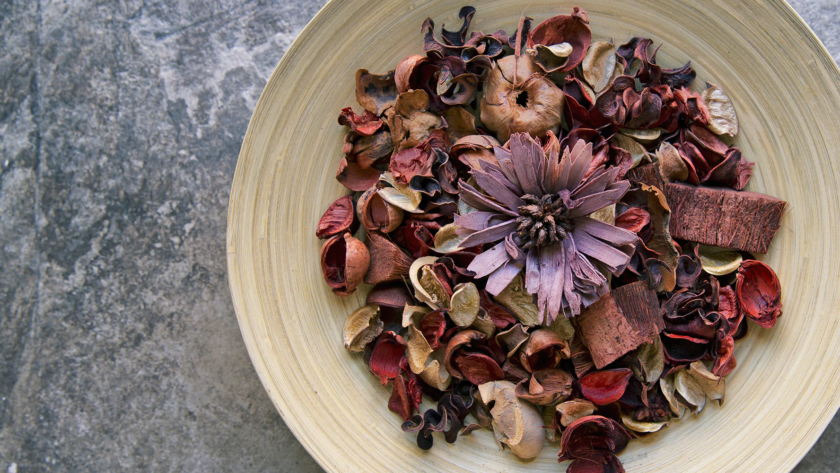In the pursuit of creating a pleasant home environment, many of us turn to the inviting scents of air fresheners and candles. However, beneath the surface of these seemingly harmless fragrances lies a hidden danger that could be impacting our health in ways we never imagined.
Recent studies have shed light on the alarming connection between conventional air fresheners and candles and their potential to disrupt our hormones and compromise respiratory well-being.
As we strive for cleaner and healthier living spaces, it’s time to reconsider the choices we make in enhancing our homes’ aroma. In this article, we delve into the hazards associated with commonly used air fresheners and candles, exploring how they can adversely affect our hormonal balance and contribute to lung pollution.
But fear not; there’s a charming and safer alternative that harks back to the simpler times of our childhood – DIY nostalgic potpourri bags. Discover how these timeless creations, reminiscent of the potpourri sachets our grandmothers once used, can fill your home with delightful scents without compromising your health.
Join us on a journey to reclaim the essence of a fragrant home, all while safeguarding your well-being.
The Hidden Dangers of Conventional Air Fresheners
For Humans:
Many commercial air fresheners, whether in spray form or as plug-ins, contain a cocktail of synthetic chemicals, such as phthalates, formaldehyde, and benzene. These substances have been linked to a myriad of health issues, including respiratory problems, headaches, and even hormonal disruptions. The Environmental Protection Agency (EPA) has identified some of these chemicals as potential indoor air pollutants, raising concerns about their impact on our overall well-being.
Inhaling these compounds regularly may lead to irritation of the eyes, nose, and throat. Long-term exposure has been associated with more serious health conditions, making it imperative to rethink the choices we make for the sake of our respiratory health.
For Animals:
Our furry friends are not immune to the risks posed by conventional air fresheners. Pets, especially birds, can be highly sensitive to airborne chemicals. Studies have shown that exposure to certain fragrances may lead to respiratory issues, allergic reactions, and even behavioral changes in animals. Considering the close proximity of pets to their owners, it’s crucial to be mindful of the products we use in our living spaces to ensure the well-being of our animal companions.
For Kids:
Children, with their developing respiratory systems and sensitive skin, are particularly vulnerable to the adverse effects of synthetic fragrances. The potential for harm extends beyond respiratory concerns, as some studies suggest a correlation between early exposure to certain chemicals found in air fresheners and an increased risk of allergies and asthma in children.
Moreover, some air fresheners release volatile organic compounds (VOCs) into the air, contributing to indoor air pollution. Children, who spend a significant amount of time indoors, may be exposed to these pollutants at higher concentrations, emphasizing the need for safer alternatives in family homes.
For the Environment:
The environmental impact of conventional air fresheners cannot be understated. The production and disposal of these products contribute to pollution and resource depletion. The release of VOCs into the atmosphere further adds to outdoor air pollution, with potential far-reaching consequences for ecosystems and biodiversity.
The Perils of Conventional Candles and Wax Melt Burners
For Humans:
While candles and wax melt burners create a cozy ambiance, the conventional varieties may be concealing health hazards. Paraffin wax, a common ingredient in many candles, releases harmful chemicals such as toluene and benzene when burned. These substances have been associated with respiratory issues and are recognized as potential carcinogens.
Wax melt burners, often filled with scented wax cubes, pose a similar risk. The synthetic fragrances used in these products can emit volatile organic compounds (VOCs) into the air, contributing to indoor air pollution. For those with respiratory conditions, such as asthma or allergies, exposure to these airborne pollutants can exacerbate symptoms and compromise overall lung health.
For Animals:
Just like with air fresheners, pets are not exempt from the potential dangers of candles and wax melt burners. Birds, in particular, are highly sensitive to airborne pollutants, and the inhalation of fumes from burning candles or melting wax can lead to respiratory distress. Additionally, curious pets may risk injury by accidentally knocking over candles, resulting in burns or fire hazards.
For Kids:
The allure of a flickering flame can be captivating for children, but it also poses risks. Accidental burns or injuries can occur if a child comes into contact with a lit candle or hot wax. Moreover, the chemicals released during the burning process can have adverse effects on developing respiratory systems, making it crucial to exercise caution when using traditional candles or wax melt burners in households with young children.
For the Environment:
The environmental impact of conventional candles is not limited to the indoor space. The production of paraffin wax, often derived from non-renewable sources like petroleum, contributes to resource depletion and environmental degradation. Additionally, the packaging and disposal of these products may add to the burden of landfills.
Rediscovering Potpourri:
A Fragrant History
Potpourri, a delightful blend of dried flowers, herbs, and spices, has been a beloved part of home fragrance for centuries. The word itself, derived from the French term “pot-pourri,” translates to “rotten pot” or “stewed pot.” Historically, potpourri was created as a method of preserving the scents of fresh flowers and herbs by layering them with salt. Over time, this practice evolved into the fragrant mixtures we recognize today.
During the Victorian era, potpourri gained popularity as a means of combating unpleasant odors and adding a touch of luxury to living spaces. It became a staple in decorative bowls and sachets, adorning parlors and bedrooms with its aromatic allure. Today, we can draw inspiration from this rich history to create our own potpourri blends, free from the health and environmental concerns associated with commercial alternatives.
Crafting Your Own Potpourri Bags: A Simple Guide
Ingredients:
- Dried Flowers: Choose a blend of your favorites-
- Herbs: Fragrant herbs like mint, rosemary, and thyme contribute depth to the mixture.
- Spices: Cinnamon sticks, cloves, and star anise provide a warm and inviting aroma.
- Citrus Peels: Dried orange or lemon peels add a burst of freshness. Dry your peels in the oven at 200 degrees until dry and fragrant.
- Essential Oils: A few drops of your favorite essential oil can enhance the scent.
Check out essential oils from Starwest Botanicals.
Instructions:
- Gather Your Ingredients: Collect a variety of dried flowers, herbs, spices, and citrus peels. You can either purchase these or dry them yourself.
- Mix Your Blend: Combine the ingredients in a bowl, adjusting the ratios to create a fragrance that appeals to you. Experiment with different combinations until you find your perfect mix.
- Add Essential Oils: For an extra burst of fragrance, add a few drops of your chosen essential oil to the mixture. Stir well to ensure an even distribution.
- Fill Sachets: Place your potpourri blend into small, breathable bags. These can be made of muslin, organza, or any other breathable fabric.
- Place Around Your Home: Distribute the potpourri bags strategically throughout your home – in drawers, closets, or any area where you’d like a subtle and natural fragrance.
The Benefits of DIY Potpourri
- Healthier Living Spaces: Unlike commercial air fresheners and candles, DIY potpourri contains no synthetic chemicals, making it a safer option for your health and the well-being of your loved ones.
- Customizable Fragrance: Tailor the scent to your preferences by experimenting with different combinations of flowers, herbs, and spices. The possibilities are endless, allowing you to create a fragrance that suits your unique taste.
- Cost-Effective and Sustainable: Making your own potpourri is not only cost-effective but also environmentally friendly. You have control over the ingredients, reducing the environmental impact associated with commercial products.
As we embrace the art of crafting our own fragrances, let the charm and simplicity of DIY potpourri bags transport you back to the days when home fragrance was both natural and enchanting. Reconnect with the tradition of creating inviting spaces that not only smell wonderful but also contribute to a healthier and more sustainable lifestyle.
Conclusion: A Fragrant Revolution for Healthier Homes
In the pursuit of creating a welcoming and aromatic home, it’s essential to reconsider the products we use to scent our living spaces. The revelations surrounding the potential health hazards associated with conventional air fresheners and candles have spurred a fragrant revolution—one that leads us back to the timeless charm of DIY potpourri bags.
As we’ve explored the dangers lurking in synthetic fragrances and the environmental toll of traditional home fragrance products, the allure of crafting our own blends becomes more apparent. DIY potpourri, with its roots deeply embedded in history, emerges as a simple yet effective solution. By combining dried flowers, herbs, and spices, we not only infuse our homes with delightful scents but also reclaim control over the ingredients, fostering a healthier environment for ourselves, our loved ones, and even our furry friends.
The journey into the world of DIY potpourri bags is not merely a return to nostalgia but a stride towards a more conscious and sustainable lifestyle. It’s an invitation to rediscover the joy of crafting, to revel in the natural scents that surround us, and to contribute to a cleaner and healthier atmosphere within our homes.
So, let the fragrant revolution begin! Embrace the art of creating your own potpourri, savoring the delightful blend of flowers, herbs, and spices that not only elevates your living spaces but also safeguards your well-being. As we bid farewell to the hidden perils of commercial air fresheners and candles, we welcome the sweet aroma of a healthier home—one potpourri bag at a time.





